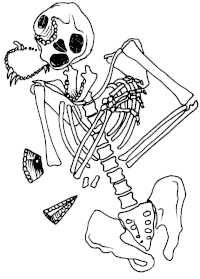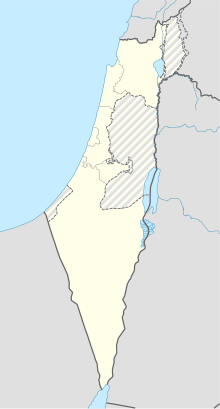| Revision as of 06:39, 10 February 2022 edit128.62.69.253 (talk) Edited to accurately reflect the geography of the region.Tag: Reverted← Previous edit |
Latest revision as of 14:40, 18 October 2024 edit undo89.153.3.107 (talk) Undid revision 1251679965 by Birdy11021954 (talk) Why is this here?Tag: Undo |
| (17 intermediate revisions by 9 users not shown) |
| Line 1: |
Line 1: |
|
|
{{Short description|Cave in Israel}} |
|
{{Infobox cave |
|
{{Infobox cave |
|
| name = Kebara Cave |
|
| name = Kebara Cave |
| Line 31: |
Line 32: |
|
}} |
|
}} |
|
|
|
|
|
'''Kebara Cave''' ( ]: مغارة الكبارة ''Mugharat al-Kabara'') is a ] ] locality in Wadi Kebara, situated at {{convert|60|to|65|m|ft|abbr=on}} ] on the western ] of the ], in the ] preserve of ].<ref>{{Cite web |url=http://www.ramat-hanadiv.org.il/sites/default/files/media/general_page/field_gp_related_files/Nature%20Park%20Map.pdf |title=map |access-date=2013-10-11 |archive-url=https://web.archive.org/web/20131010233100/http://www.ramat-hanadiv.org.il/sites/default/files/media/general_page/field_gp_related_files/Nature%20Park%20Map.pdf |archive-date=2013-10-10 |url-status=dead }}</ref> |
|
'''Kebara Cave''' ({{langx|he|מערת כבארה|Me'arat Kebbara}}, {{langx|ar|مغارة الكبارة|Mugharat al-Kabara}}) is a ] ] locality in Wadi Kebara, situated at {{convert|60|to|65|m|ft|abbr=on}} ] on the western ] of the ], in the ] preserve of ].<ref>{{Cite web |url=http://www.ramat-hanadiv.org.il/sites/default/files/media/general_page/field_gp_related_files/Nature%20Park%20Map.pdf |title=map |access-date=2013-10-11 |archive-url=https://web.archive.org/web/20131010233100/http://www.ramat-hanadiv.org.il/sites/default/files/media/general_page/field_gp_related_files/Nature%20Park%20Map.pdf |archive-date=2013-10-10 |url-status=dead }}</ref> |
|
|
|
|
|
==History== |
|
==History== |
|
The cave was inhabited between 60,000 and 48,000 ] and is famous for its ] finds of ] remains, made under the direction of Professor ]. |
|
The cave was inhabited between 60,000 and 48,000 ] and is famous for its ] finds of ] remains. |
|
|
|
|
|
|
] and ] excavated in the cave in the early 1930s. Excavations have since yielded a large number of human remains associated with a ] archaeological context. The first specimen discovered in 1965, during the excavations of M. Stekelis, was an incomplete infant skeleton (Kebara 1).<ref></ref> |
| ⚫ |
] and ] excavated in the cave in the early 1930s, but by far the most significant discovery made at Kebara Cave was ] in 1982, the most complete postcranial ] ] found to date. Nicknamed "Moshe" and dating to ''circa'' 60,000 ], the skeleton preserved a large part of one individual's torso (], ]s and ]). The ] and most of the lower limbs were missing. The ] was also preserved, and was the first Neanderthal hyoid bone found.<ref name="mithen">](2006). The Singing Neanderthals: The origins of music, language, mind, and body. Cambridge, Massachusetts: Harvard University Press.</ref> |
|
|
|
|
|
|
⚫ |
The most significant discovery made at Kebara Cave was ] in 1982, the most complete postcranial ] ] found to date. Nicknamed "Moshe" and dating to ''circa'' 60,000 ], the skeleton preserved a large part of one individual's torso (], ]s and ]). The ] and most of the lower limbs were missing. The ] was also preserved, and was the first Neanderthal hyoid bone found.<ref name="mithen">](2006). The Singing Neanderthals: The origins of music, language, mind, and body. Cambridge, Massachusetts: Harvard University Press.</ref> |
| ⚫ |
The ] culture is named after the site. |
|
|
|
|
|
⚫ |
The ] is named after the site. |
|
|
|
|
|
== See also == |
|
== See also == |
|
* ] |
|
* ] |
|
* ] ''(with link directory)'' |
|
* ] ''(with link directory)'' |
|
* ] |
|
* ] |
| ⚫ |
* ] |
|
|
* ] |
|
* ] |
|
⚫ |
* ] |
|
|
|
|
|
==References== |
|
==References== |
| Line 59: |
Line 62: |
|
==External links== |
|
==External links== |
|
{{Commons category}} |
|
{{Commons category}} |
|
* - the Rothschild Memorial public gardens at ] preserve the Kebara Cave within their boundaries for visitors |
|
* {{Webarchive|url=https://web.archive.org/web/20110716080625/http://www.ramat-hanadiv.org.il/index_en.aspx |date=2011-07-16 }} - the Rothschild Memorial public gardens at ] preserve the Kebara Cave within their boundaries for visitors |
|
* at About.com |
|
* {{Webarchive|url=https://web.archive.org/web/20050922073231/http://archaeology.about.com/library/glossary/bldef_kebara.htm |date=2005-09-22 }} at About.com |
|
|
|
|
|
{{Epipalaeolithic Southwest Asia}} |
|
{{Epipalaeolithic Southwest Asia}} |
|
{{Navbox prehistoric caves}} |
|
{{Navbox prehistoric caves}} |
|
{{Caves in Palestine}} |
|
{{Caves in Israel}} |
|
{{Homo neanderthalensis|state=expanded}} |
|
{{Homo neanderthalensis|state=expanded}} |
|
{{Authority control}} |
|
{{Authority control}} |
|
|
|
|
|
{{DEFAULTSORT:Kebara}} |
|
{{DEFAULTSORT:Kebara}} |
|
] |
|
] |
|
|
] |
|
] |
|
] |
|
] |
|
] |
|
] |
|
] |
|
|
] |
|
|
] |
|
|
] |
 Kebara 2 in situ
Kebara 2 in situ
